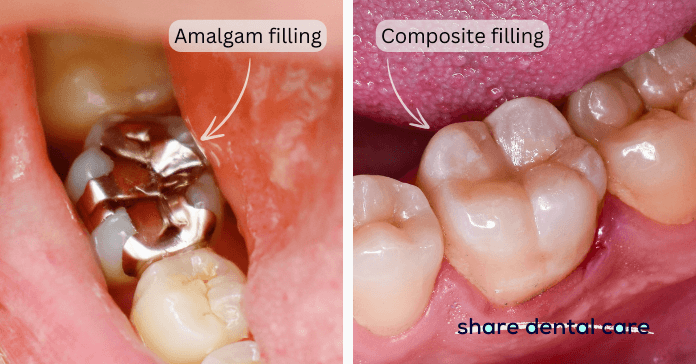If you are struggling with a cavity or tooth decay, your dentist may recommend a filling. However, it can be difficult to know which type of filling is best for you. Amalgam and composite fillings are two of the most popular types of fillings, and each one has its advantages and disadvantages. In this blog post, we will explore the differences between amalgam vs composite fillings to help you make a more informed decision about which one is right for you.
Comparison Between Amalgam vs Composite Fillings
In this blog post, we will compare amalgam vs composite fillings in terms of composition, aesthetics, durability, and cost.
Composition
Amalgam fillings are made up of a combination of metals, including silver, copper, tin, and mercury. This mixture creates a strong and durable filling that can withstand the force of chewing. Some people are concerned about the mercury content in amalgam fillings. However, the American Dental Association (ADA) asserts that amalgam fillings are safe for most patients.
On the other hand, composite fillings (white fillings) are made up of a blend of plastic resins and glass filler materials. Composite material can be color-matched to your teeth, making them more aesthetically pleasing than amalgam fillings.
Aesthetics
As mentioned earlier, composite fillings are tooth-colored and can be matched to the color of your natural teeth. This makes them a more aesthetically pleasing option compared to amalgam fillings, which are silver in color and highly visible when you open your mouth. This may be a concern for patients who prefer a more natural look.

Durability of Amalgam vs Composite Fillings
Amalgam fillings have been used for over 150 years and are known for their durability. They can withstand heavy chewing and last for 10-15 years, making them a reliable choice for filling cavities.
Composite fillings, on the other hand, are less durable than amalgam fillings and typically last for 5-7 years. This is because the plastic material used in composite fillings is not as strong as metal and can wear down over time. So, you may need to replace composite fillings more frequently compared to amalgam fillings.
Cost
The cost of amalgam and composite fillings can vary based on factors such as location, dentist expertise, and the size of the filling needed. Generally, amalgam fillings are less expensive than composite fillings because they use cheaper materials and require less time to place.
Composite fillings require more time and skill to place, which makes them more costly. However, if appearance is a concern, composite fillings may be worth the extra cost.
Safety
One of the main concerns when it comes to dental fillings is safety. Amalgam fillings contain a small amount of mercury, which can be toxic in high doses. However, according to the ADA and other health organizations, the levels of mercury used in amalgam fillings are considered safe for most individuals.
Composite fillings, on the other hand, do not contain any mercury and are considered a safer alternative by some patients. However, they may contain small amounts of BPA (bisphenol A), which is a controversial chemical that has been linked to health issues in some studies.
Amalgam vs Composite Fillings: Which One is Better?
When it comes to choosing between amalgam and composite fillings, there is no clear winner. Both types have their advantages and disadvantages, and the best choice will depend on individual factors, such as the location of the tooth, your budget, and personal preferences.
Amalgam fillings may be a better option for those on a budget or looking for a long-lasting filling. However, if appearance and potential health risks are major concerns, composite fillings may be the way to go. It’s always best to discuss your options with your dentist and make an informed decision based on your
Amalgam vs Composite Fillings – Conclusion
In conclusion, both amalgam and composite fillings have their advantages and disadvantages. Amalgam fillings are known for their durability and affordability, while composite fillings offer a more natural appearance. Ultimately, the best choice for filling cavities depends on individual preferences and needs.
Consult with a dentist to determine the best option for your specific case. Regardless of the type of filling chosen, it is crucial to maintain good oral hygiene and regular dental check-ups to prevent further decay and maintain overall oral health.